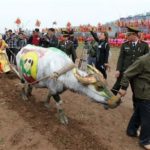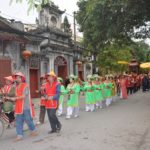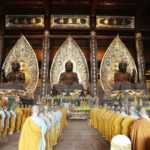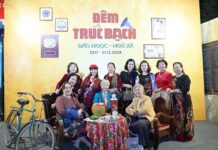Cau Giay District is a historically rich area located in Thang Long (now Hanoi). It is home to numerous traditional craft villages and boasts a proud heritage.
The name Cau Giay originated from the traditional paper-making practices of different villages. In Yen Hoa, villagers specialized in producing raw paper, known as “do” (poonah) paper. In An Thai, they focused on making “giay ban” (paper for common people’s use), while Nghia Do villagers were skilled in crafting “giay sac phong” (paper used to create king’s certificates to grant titles to individuals).
Paper Making Craft
Cau Giay District, situated in the western region of Hanoi, has undergone several administrative boundary adjustments. As it stands, the district consists of 8 wards. It shares borders with Tay Ho and Bac Tu Liem Districts in the north, Dong Da and Ba Dinh districts in the east, Thanh Xuan District in the south, and Nam Tu Liem District in the west.
| Cau Giay (Paper Bridge) in the past. File photo |
Cau Giay is a district in Hanoi, Vietnam that is known for its handicraft villages. One of the famous villages in Cau Giay is Vong Village, also known as Dich Vong Hau. Vong Village is well-known for its production of com, a specialty of Hanoi cuisine, which are young green sticky rice flakes. Another noteworthy village in Cau Giay is Gian Village, which specializes in the production of incense. Nghia Do Village is yet another handicraft village in Cau Giay that is renowned for its production of malt candy. These handicraft villages contribute to the cultural and economic diversity of Cau Giay district.
The residents of Cau Giay are renowned for their dedication to education. Within the villages of Giay (Thuong Yen Quyet) and Cot (Ha Yen Quyet), there are 18 individuals who have attained a Ph.D. Additionally, in ancient times, Cau Giay was home to hundreds of bachelors.
Cau Giay District is home to numerous historical, cultural, and revolutionary relics.
Now, Cau Giay has developed into a metropolitan district with a modern urban infrastructure as part of Hanoi’s expansion towards the west.
Many prestigious schools are situated in the district, such as the Academy of Journalism and Communication, the University of Languages and International Studies, and the Vietnam National University.
The economy of Cau Giay District has consistently focused on services, trade, industry, and construction as key sectors to drive economic growth and enhance living standards.
Cau Giay District is proud to be the home of the first centralized Information Technology Park in Hanoi.
| Cau Giay District nowadays. Photo: The Hanoi Times |
Bui Tuan Anh, Chairman of the Cau Giay District People’s Committee, emphasized the commitment of the local government to enhancing the well-being of its residents and providing unwavering support to businesses.
In the forthcoming period, Cau Giay District is committed to enhancing its infrastructure and ensuring the well-being of its residents.
“In addition to business development, we also prioritize the well-being of our community, offering support to individuals facing challenges such as disabilities, veterans, families of fallen heroes, and those in difficult circumstances within the district,” he stated.
Famous Destinations
Cau Giay District is home to numerous renowned monuments and attractions that are a must-see for tourists.
Ha Pagoda
The Ha Pagoda, constructed in the 6th century, serves as a popular destination for Buddhists and tourists alike. Situated in a serene and tranquil environment, this sacred site offers visitors a serene and calming experience.
Many young people visit Ha Pagoda to pray for love and happiness, although the pagoda is not associated with any love-related legends.
Vong Village
Vong Village is renowned for its green sticky rice, which is a key ingredient in Hanoi delicacies such as banh com (green sticky rice cake filled with mung bean), com xao (fried green sticky rice), and xoi com (green sticky rice cooked with mung bean and lotus seeds).
| Vong villager makes green rice flakes. Photo: The Hanoi Times |
Legend has it that many centuries ago, when the rice was about to be harvested, a natural disaster flooded the entire field. To avoid starvation, the Vong villagers cut the young rice grains and roasted them for better preservation. This improvised preparation gave the dish an extremely delicious taste, so it has been handed down to the present day.
Vietnam Museum of Ethnology
The museum is situated on Nguyen Van Huyen Street, 8 km from the city center, and spans across 4.5 hectares of land. It serves as a repository for the rich cultural and historical heritage of the 54 ethnic groups in Vietnam. Regarded as the largest and most captivating ethnology museum in the country, it showcases a diverse array of cultural artifacts and showcases the unique traditions and customs of the Vietnamese people.
The Vietnam Museum of Ethnology is a hub dedicated to the study, acquisition, conservation, and restoration of cultural artifacts and materials belonging to various ethnic groups. Additionally, it hosts exhibitions, performances, and other events to showcase the rich cultures of both local and international ethnic communities.
The concept of the Vietnam Museum of Ethnology originated in the 1980s during the challenging post-war period. Despite the difficult socio-economic conditions, the idea materialized and on October 24, 1995, the Prime Minister officially established the Vietnam Museum of Ethnology.
On November 12, 1997, the museum was inaugurated during the Francophone Summit in Hanoi, in the esteemed company of Vietnamese Vice President Nguyen Thi Binh and French President Jacques Chirac.











